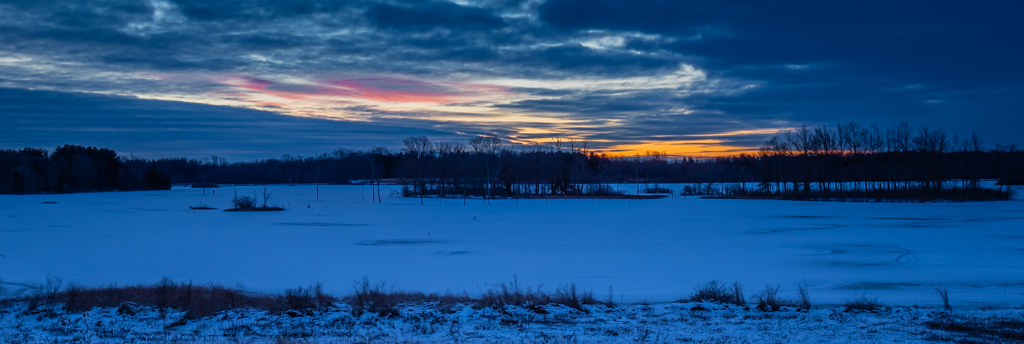Pierre Williot
About the Image(s)
Equipment: Canon EOS 6Dii, Canon EF 16-35 f/2.8L ii, cable release, Sturdy tripod
Settings: ISO 400, 35mm (full frame), f/13, 5 bracketed images at 1/80-1/40-1/20-1/10 and 1/5th sec. (one stop between each image with mid point was a minus 2 stops)
Process: Images combined, Cropping, Lens profile correction, light adjustments in LightRoom
When I took these images I was attracted by the blue hours, different sky coloration from the sun which was still below the horizon as well as the cloud striations. Earlier on, I was quite discouraged by the very cloudy sky, but then the magic happened!
Point to discuss: I find that when I bracket the morning twilight/early sunrise, I like to under expose. I believe that this is giving me more latitude in the reinforcement of the sunlight colors catching the undersurface of the clouds. I also use the graduated filter to slightly decrease the highlights, a tad more saturation and a little less exposure. I used another graduated filter to slightly increase the exposure, whites and highlights on the bottom half of the image.
Cheers,
Pierre
This round’s discussion is now closed!
10 comments posted
I agree with you with the use of the graduated neutral density filters (hard or soft or inverted) at the time of the capture, unfortunately, I did not have them with me at the time. I find that one of the advantage in post processing is the variety of options available on the computer such as tweaking shadows, saturations, etc.... But all these tweaks can be used regardless of the way the image was captured.
I will bring my filters next time! Thanks for reminding me! Posted: 02/26/2021 16:05:47
Let me response straight to the point you want to discuss. Like you, I always shot this kind of scene with bracketed exposure. You combined 5 bracketed in LR. I would normally combine it as layers in PS. Most likely, I will choose the one that I think is the best as my base layer. I would then choose and pick other part of the image by using Mask Tool. In some situation, I use Luminosity Mask. I really appreciate your efforts to capture this image. Posted: 02/24/2021 19:26:02
Kudos to your effort of getting out bed in the dark, putting on your heavy coat and bringing along all your gear hoping for a great sunrise. I believe your experience of being there made this image memorable. Enjoy it very much. Posted: 02/26/2021 15:36:21
Really cold before the sun is up!
I am an early bird and prefer sunrise to sundown. Waking up early in the morning allows to see all the transitions from dark to bright and at the end, it is very easy to start the day energized by the experience of seeing it all happen! (Furthermore the longer one stay, the warmer it gets....)
One can do the same with sundown but then it is very dark outside and it gets progressively colder (I also get impatient as I want to go to bed!). Posted: 02/26/2021 16:11:51
We now have so many choices beyond Adobe in our workflow; Topaz Studio 2, On 1, Luminar AI, Capture One, a little of this, a little of that. I find these multiple choices really opens up my creative flow, especially if you consider using sky replacements and textures.
So the question boils down to what is your intent? How do you pre-visualize the finished image so viewer sees it in a new way? How do you make it yours? Let go. Take the Risk. Develop your personal style. Is your vision of a natural image or creative? The choice is yours. Posted: 02/27/2021 08:25:00
Posted: 02/27/2021 11:42:56
I think bracketing is a good approach to this kind of scene. Often I will take one bracket for the sky and refocus on the foreground and shoot another complete bracket. I then have a lot of data to use later in post. My only suggestion for this image would be to push all of the sky highlights towards orange as the blue and the orange you do have in the sky look really nice together.
Todd Posted: 02/28/2021 15:04:47
